Preparing a property to attract buyers requires strategy. This process, often called home staging, transforms spaces to highlight their potential. Studies show staged properties often sell faster and at higher prices compared to unstaged ones. New Homes Alberta specializes in this art, blending design principles with real estate expertise to create inviting, market-ready listings.
Effective staging isn’t just about decoration. It’s about emphasizing a property’s strengths while aligning with buyer expectations. For example, neutral tones and decluttered rooms help buyers visualize themselves in the space. Current market trends also play a role – modern layouts or energy-efficient features might take center stage depending on demand.
New Homes Alberta offers tailored guidance to simplify this process. Their team provides actionable advice, from rearranging furniture to optimizing lighting. Whether you’re downsizing or upgrading, their experts ensure your property stands out. Ready to learn more? Call (403) 305-9167 for personalized support.
This guide shares proven methods to prepare your space efficiently. You’ll discover practical tips for enhancing curb appeal, arranging rooms strategically, and leveraging professional insights to maximize value.
Key Takeaways
- Staging improves visual appeal and often leads to quicker, higher-value sales.
- Neutral designs help buyers imagine living in the space.
- Market trends influence which features to emphasize during staging.
- Professional guidance saves time and reduces stress.
- Small adjustments like lighting and furniture placement make significant impacts.
Understanding Home Staging and Its Benefits
Transforming a property into a buyer magnet involves strategic design choices. Unlike decorating, which reflects personal taste, staging focuses on universal buyer preferences. This method highlights a property’s best features while minimizing distractions. According to New Homes Alberta, listings with professional staging spend 73% less time on the market compared to unstaged properties.
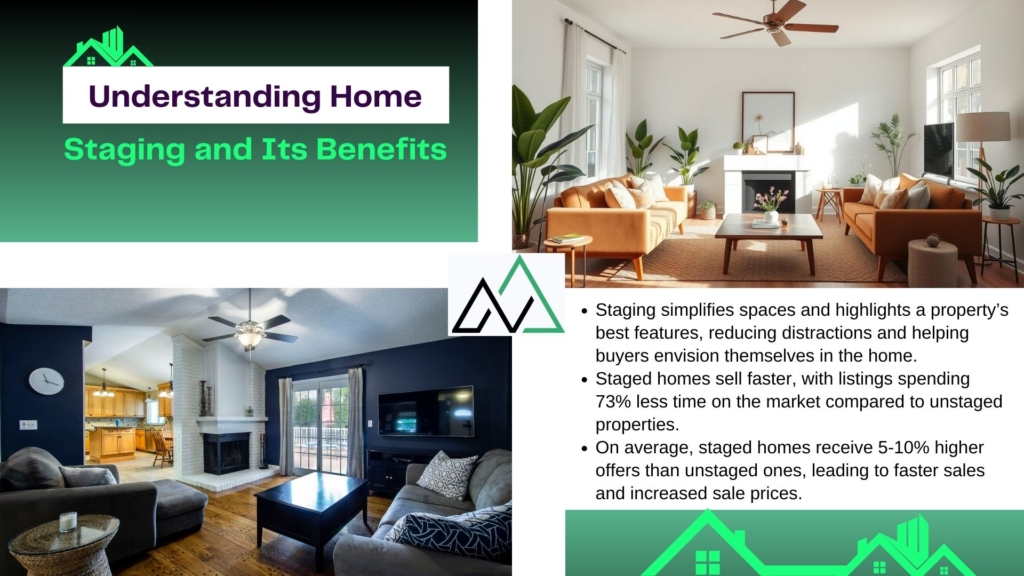
Why Staging Enhances Home Appeal
Buyers often struggle to see past cluttered rooms or bold decor. Staging simplifies spaces, emphasizing functionality and flow. Neutral color schemes and depersonalized layouts let potential buyers imagine their lives unfolding there. For example, a staged living room might showcase cozy seating areas rather than family photos or collectibles.
Key Benefits for Sellers and Buyers
Staging creates a win-win scenario. Sellers benefit from faster sales and competitive offers, while buyers gain clarity about a property’s potential. Data from Canadian real estate boards reveals staged homes sell for 5-10% above asking prices on average.
| Factor | Staged Homes | Unstaged Homes |
|---|---|---|
| Average Days Listed | 23 | 67 |
| Offers Received | 3.2 | 1.5 |
| Sale Price vs. Asking | 102% | 96% |
Emotional connections drive decisions in real estate. A well-staged bedroom with crisp linens and soft lighting feels inviting, not just functional. New Homes Alberta notes that 82% of buyers find staged properties easier to evaluate, reducing hesitation during offers.
The Role of Real Estate in Home Staging
Staging has become a cornerstone of modern real estate marketing strategies. Professionals recognize its power to shape buyer perceptions and accelerate sales. Over 68% of agents in Canada now partner with staging experts, according to industry surveys. This collaboration ensures properties meet current market expectations while highlighting their unique strengths.

Agents play a critical role in guiding sellers through the staging process. They assess a property’s potential, recommend focal points like living areas or kitchens, and coordinate with stagers to optimize space utilization. For instance, rearranging furniture to create open pathways can make compact rooms feel expansive. These adjustments directly influence buyer interest during showings and open houses.
Well-executed staging elevates a listing’s perceived value, benefiting both sellers and real estate professionals. Properties presented effectively often receive multiple offers, reducing negotiation timelines. As one Calgary-based agent notes, “A staged property doesn’t just sell faster—it sets the tone for competitive bidding.” By aligning staging with broader marketing efforts, estate experts ensure listings stand out through enhanced photography and maximized functional space in promotional materials.
Preparing Your Space: Cleaning, Decluttering, and Depersonalizing
A spotless, neutral environment forms the foundation of buyer interest. This phase requires meticulous attention to detail, transforming lived-in spaces into blank canvases that invite imagination. Start by assessing each area objectively—what feels welcoming versus distracting?
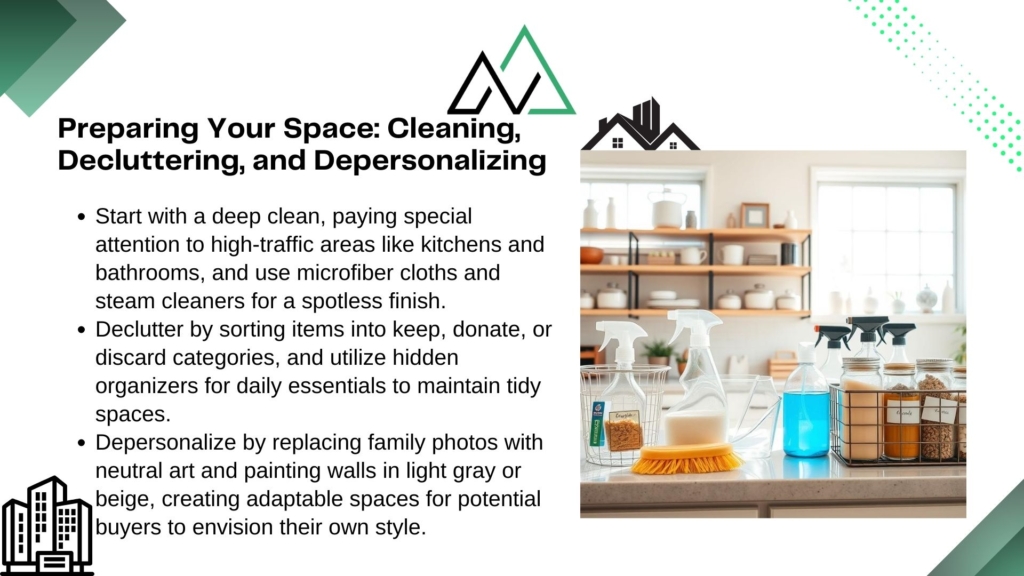
Effective Cleaning Techniques
Begin with a room-by-room deep clean. Focus on high-traffic zones like kitchens and bathrooms, where grime accumulates unnoticed. Use microfiber cloths for streak-free surfaces and steam cleaners to sanitize tiles. Make sure appliances shine inside and out—buyers often inspect ovens and refrigerators.
Decluttering and Neutralizing Spaces
Remove excess items to highlight square footage. Sort belongings into three categories: keep, donate, or discard. Seasonal decor and rarely used furniture often belong in temporary storage. For daily essentials, utilize hidden organizers to maintain tidy countertops and closets.
Depersonalizing is equally critical. Replace family photos with abstract art and store memorabilia that reflects personal tastes. A fresh coat of light gray or beige paint modernizes walls without overwhelming buyers. This process creates airflowy, adaptable rooms ready for new owners to imprint their style.
Finally, make sure every space feels expansive. Rearrange furniture to maximize flow and eliminate visual clutter. Buyers gravitate toward storage-rich, orderly environments where they can envision their future—not yours.
How to Stage a Home for Sale
Strategic room design directly influences buyer decisions. Primary spaces like kitchens and living areas leave lasting impressions, with 89% of realtors emphasizing their impact on offers. Industry data shows listings with professionally staged primary rooms receive 2.3x more view requests.

Highlighting Primary Rooms: Living Room, Kitchen, and Bedrooms
Focus on the kitchen’s cleanliness and functionality. Clear countertops except for a bowl of fresh fruit or neutral decor. A 2023 Canadian Staging Professionals report found staged kitchens receive 40% more clicks in online listings compared to unstaged ones.
Living areas should feel cohesive. Arrange furniture to create conversation zones, avoiding overcrowding. For example, position sofas facing each other with a central coffee table. This layout enhances flow while showcasing square footage.
| Feature | Staged Rooms | Unstaged Rooms |
|---|---|---|
| Buyers’ Visual Engagement | 82% | 47% |
| Perceived Space | 18% Larger | Baseline |
| Online Listing Clicks | 2.1x Higher | Standard |
Bedrooms require tranquility. Use crisp bedding in neutral tones and limit personal items. Symmetrical furniture arrangements, like matching nightstands, convey balance. Staging home experts suggest adding a reading chair near windows to highlight natural light.
Don’t overlook the dining room. Set the table with simple place settings and a centerpiece like greenery. This transforms the space from empty to functional, helping buyers envision gatherings. Stage home strategies often use this technique to create emotional connections during walkthroughs.
Enhancing Curb Appeal and Exterior Features
A property’s exterior acts as its handshake with potential buyers. Research from the Canadian Real Estate Association reveals listings with polished outdoor spaces receive 34% more inquiries than those lacking visual charm. First impressions form within seconds, making every detail—from trimmed hedges to clean walkways—critical for sparking interest.
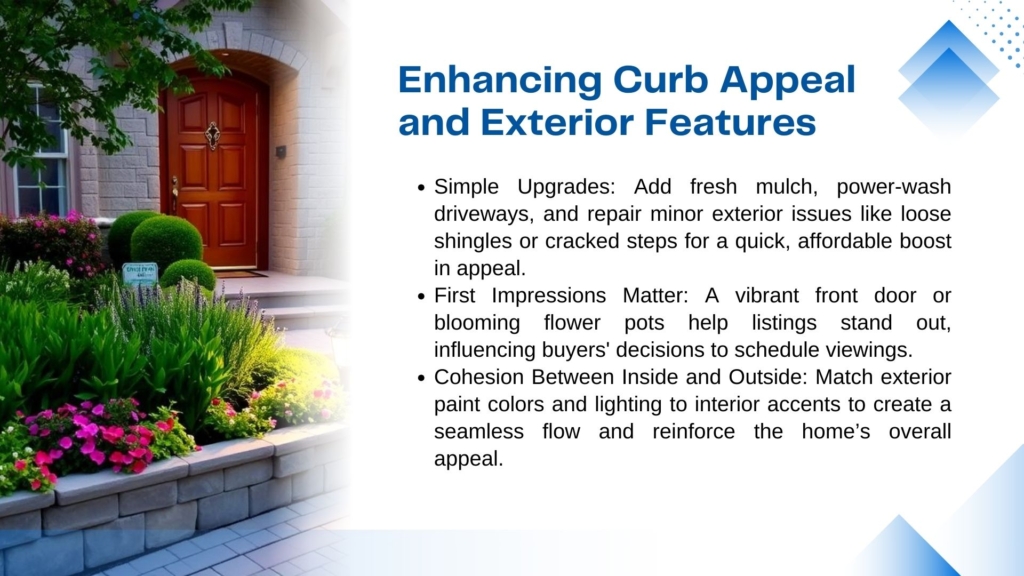
Improving Your Home’s First Impression
Simple upgrades create immediate impact. Fresh mulch in garden beds adds color contrast, while power-washing driveways removes years of grime. Repair loose shingles or cracked steps to signal meticulous upkeep. These efforts cost little but elevate perceived value significantly.
| Factor | Enhanced Curb Appeal | Basic Exterior |
|---|---|---|
| Days on Market | 19 | 42 |
| Offers Received | 2.8 | 1.1 |
| Photo Engagement | 67% Higher | Baseline |
High-quality exterior photos drive online engagement. A vibrant front door or blooming flower pots make listings stand out in digital searches. Over 78% of buyers report these images influence their decision to schedule viewings.
Align outdoor improvements with interior staging. Paint the garage door to match interior accents, or add pathway lighting that echoes indoor fixtures. This cohesion reinforces the house’s overall appeal, helping buyers envision it as their future sale investment.
Maximizing Natural Light and Interior Ambiance
Bright, airy spaces consistently rank high on buyer wish lists. A University of Calgary study found properties with abundant natural light sell 19% faster than dimly lit counterparts. This element not only elevates mood but also creates an illusion of spaciousness—a critical factor in today’s competitive market.

Strategies for Utilizing Natural Light
Start by removing heavy drapes and cleaning windows thoroughly. Even subtle grime can block up to 30% of sunlight. Replace dark blinds with sheer curtains or leave windows bare during showings. Mirrors placed opposite glass doors amplify brightness, making rooms feel larger and more inviting.
Balance is key. Layer ambient lighting—like floor lamps—with task lighting near reading nooks. Warm LED bulbs (2700-3000K) complement daylight without creating harsh contrasts. In evening viewings, this blend ensures spaces remain welcoming long after sunset.
Photography benefits immensely from well-planned illumination. Open all window coverings during photo shoots and schedule sessions during “golden hour” for soft, flattering rays. Listings with sunlit interiors receive 41% more online engagement, according to RE/MAX Canada data.
Buyers associate bright environments with positivity. A living area bathed in morning light feels energizing, while softly lit bedrooms suggest relaxation. These emotional triggers often translate into stronger offers and quicker decisions.
Furniture and Layout: Creating an Inviting Environment
Thoughtful furniture choices transform empty rooms into aspirational spaces. Industry reports indicate 76% of buyers rate layout as crucial when evaluating properties. Properly scaled pieces and intentional flow help visitors visualize daily life in the space.
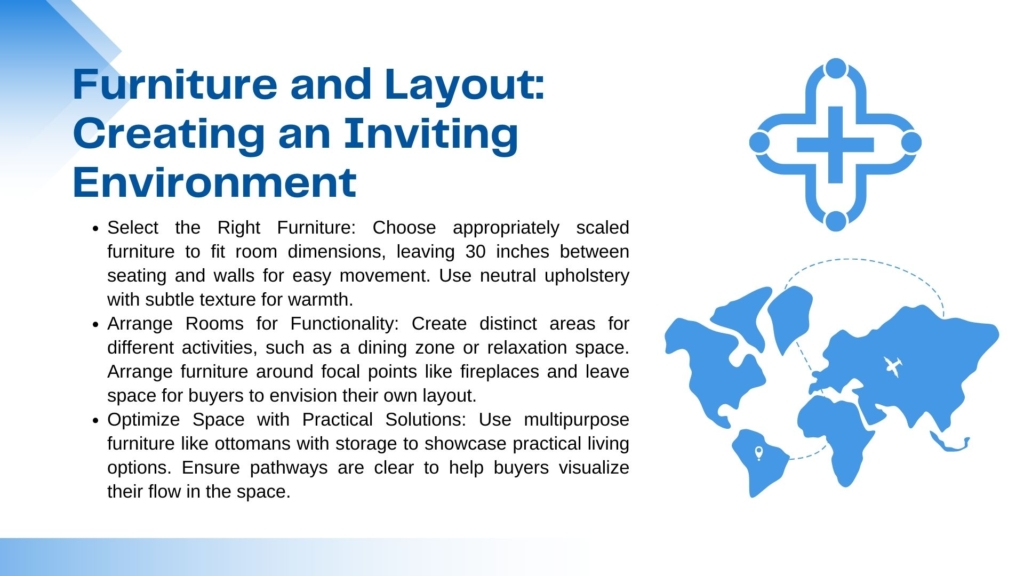
Selecting the Right Furniture
Oversized couches shrink rooms, while petite sets feel insubstantial. Aim for balanced proportions—leave 30 inches between seating and walls for walkways. Neutral upholstery with textured throw pillows adds warmth without overpowering.
Optimal Room Arrangements for Buyer Appeal
Define clear areas for activities like dining or relaxing. Position sofas to face focal points like fireplaces, creating natural conversation zones. Leave enough empty space to suggest where buyers might place their own belongings.
| Factor | Staged Layout | Empty Room |
|---|---|---|
| Furniture Scale | Matches room dimensions | Random sizing |
| Functional Zones | 3+ defined areas | Single-purpose use |
| Buyer Perception | “I could live here” | “Needs work” |
Make home strategies include adding multipurpose items like ottomans with storage. These demonstrate practical living solutions. Always make sure pathways remain unobstructed—buyers mentally map their movements during walkthroughs.
Designate specific areas for leisure or work using area rugs or lighting. Imagine a cozy reading nook by the window or a laptop-friendly corner desk. These touches help buyers imagine building their routines in the room.
Staging Tips from Industry Experts and Trends
Industry leaders consistently refine their methods to align with shifting buyer preferences. Modern staging home strategies blend timeless principles with innovative adaptations, ensuring properties resonate across demographics. A 2024 survey by the Canadian Real Estate Association found 91% of top-performing agents prioritize staging in their marketing plans.
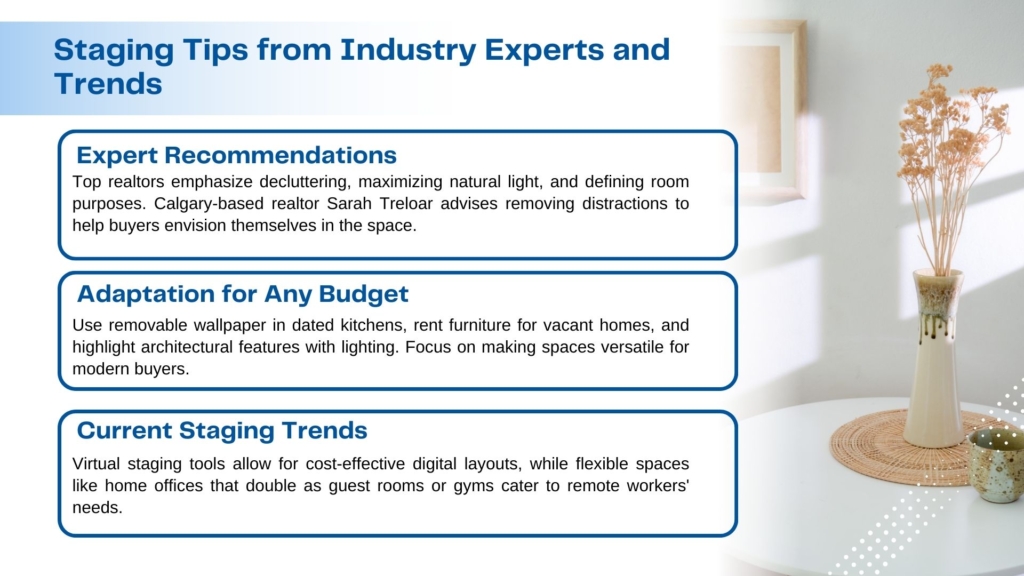
Expert Recommendations from Top Realtors
Leading agents emphasize three universal rules: declutter relentlessly, amplify natural light, and define room purposes. Calgary-based realtor Sarah Treloar notes, “Buyers need to see themselves in the space—remove anything that distracts from that vision.” Her team reduces average market time by 22 days through pre-listing staging consultations.
Adapt these tips to any budget or property type:
- Use removable wallpaper in dated kitchens for instant modernization
- Rent furniture bundles for vacant properties
- Highlight architectural details with directional lighting
Current trends show increased demand for flexible spaces. Home offices that double as guest rooms or workout areas appeal to remote workers. Virtual staging tools now let buyers imagine multiple layout options digitally—a cost-effective solution for vacant listings.
| Traditional Approach | Modern Adaptation |
|---|---|
| Neutral paint only | Accent walls in muted tones |
| Formal dining setups | Convertible tables for work/meals |
| Generic artwork | Local artisan pieces as focal points |
Timing remains critical. Complete staging before photography sessions to maximize online engagement. As Edmonton stager Marco Li advises, “First impressions are digital—ensure your stage home efforts translate flawlessly to listing photos.”
Budgeting for Home Staging: Cost and ROI Considerations
Smart financial planning separates successful property presentations from overlooked listings. Allocating resources effectively ensures maximum buyer appeal while protecting profit margins. Industry data reveals staged properties sell for 5-11% above asking price on average, making every dollar a strategic investment.
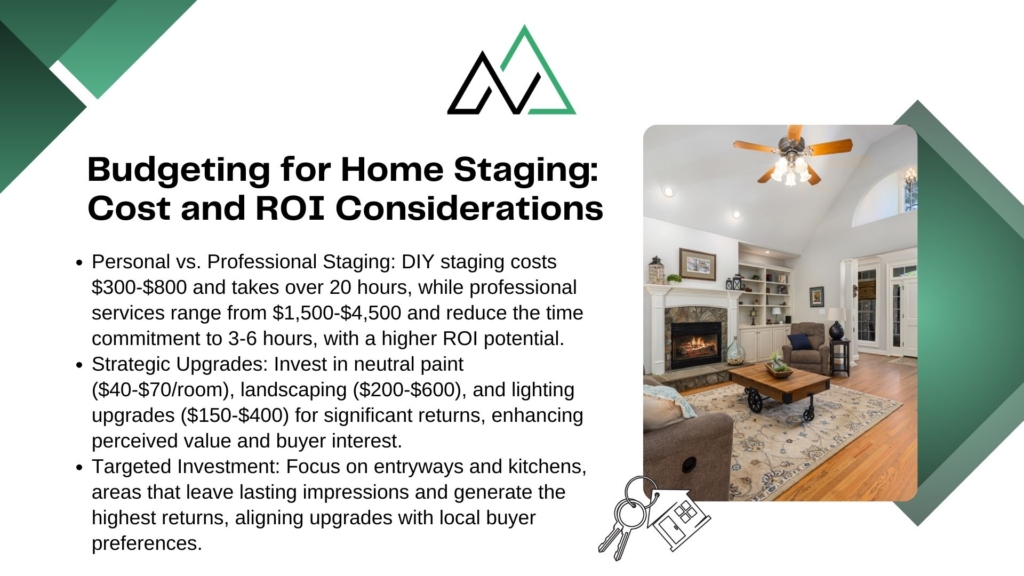
Personal Staging vs. Professional Services
Homeowners often debate handling the process themselves versus hiring experts. DIY methods save upfront costs but demand significant time and design skills. Professional stagers bring market insights, often negotiating better furniture rental rates and optimizing layouts for photography.
| Factor | Personal Staging | Professional Service |
|---|---|---|
| Average Cost | $300-$800 | $1,500-$4,500 |
| Time Commitment | 20+ Hours | 3-6 Hours |
| ROI Potential | 2-4% Increase | 5-8% Increase |
Strategic Upgrades That Boost Value
Focus on changes offering the highest return per dollar spent. Fresh paint in neutral tones modernizes interiors for under $50 per room. Energy-efficient lighting fixtures or updated cabinet hardware also deliver outsized impacts.
| Investment | Cost Range | Potential Sale Impact |
|---|---|---|
| Neutral Paint | $40-$70/room | +1.5% Price |
| Landscaping | $200-$600 | +3% Buyer Interest |
| Lighting Upgrades | $150-$400 | +2.1% Perceived Value |
Collaborate with your real estate agent to prioritize upgrades matching local buyer preferences. As Calgary agent Mia Renwick advises, “Invest where eyes linger—entryways and kitchens.” These targeted improvements shorten market time while elevating perceived value.
Leveraging Home Staging for Online Appeal
In today’s digital-first market, a property’s online presence often determines its success. Listings with professional photos receive 118% more views than those with amateur shots, according to the Canadian Real Estate Association. Staged homes consistently outperform unstaged properties in visual appeal, creating emotional connections before buyers ever step inside.
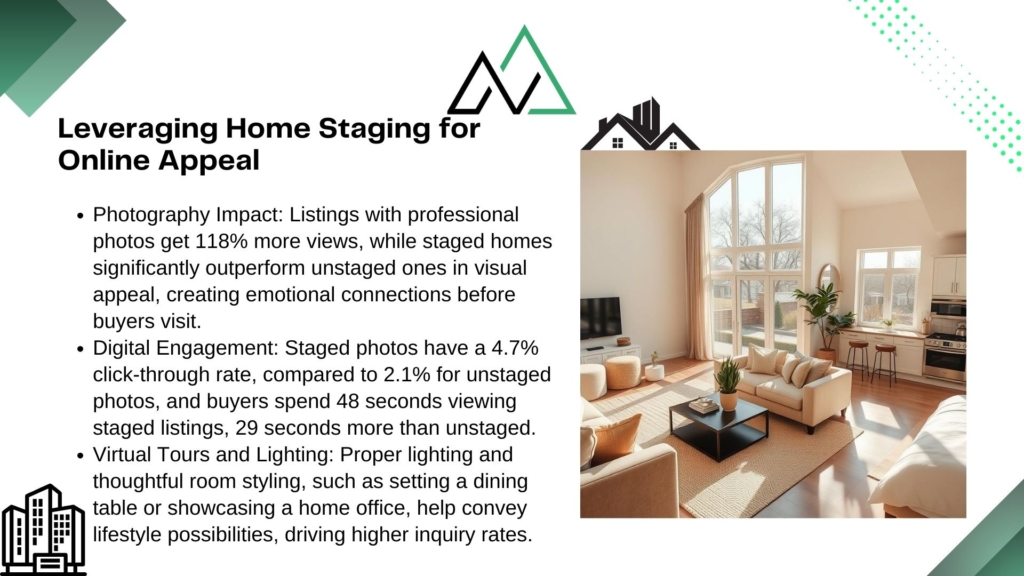
Photography Strategies That Drive Engagement
Preparing spaces for cameras requires different tactics than physical showings. Remove small decor items that create visual noise in wide shots. Angle furniture diagonally to add depth, and use fresh flowers or greenery to inject color without overwhelming the scene.
| Factor | Staged Photos | Unstaged Photos |
|---|---|---|
| Average Click-Through Rate | 4.7% | 2.1% |
| Time Spent Viewing | 48 seconds | 19 seconds |
| Offer Likelihood | 68% Higher | Baseline |
Lighting makes or breaks digital appeal. Open all window coverings and schedule shoots during midday for balanced illumination. Professional stagers often use bounce boards to soften shadows in darker areas like hallways or basements.
Potential buyers increasingly make decisions based on virtual tours. Ensure each room tells a story – a neatly set dining table suggests holiday gatherings, while a styled home office hints at productivity. These subtle cues help listings stand out in crowded marketplaces.
Agents report professionally staged properties generate 3x more online inquiries within the first week. As Toronto photographer Liam Chen notes, “Great staging turns rooms into scenes – buyers don’t just see walls, they see possibilities.”
Key Takeaways on Staging Your Home for a Quick Sale
Mastering property presentation unlocks competitive advantages in real estate transactions. Through decluttering, neutralizing decor, and emphasizing flow, sellers create environments where potential buyers envision their futures. Statistics reinforce this approach: staged properties sell 73% faster and achieve 5-10% higher prices than unprepared listings.
New Homes Alberta’s expertise simplifies the process. Their team helps sellers highlight architectural strengths while aligning with market trends. From optimizing natural light to arranging furniture for maximum impact, these strategies transform ordinary spaces into irresistible listings.
Key takeaways for success:
- Neutral palettes and depersonalized layouts broaden buyer appeal
- Professional photography captures staged rooms’ full potential
- Collaborating with experienced agents ensures market-ready results
Data from Canadian real estate boards confirms staged homes receive 3x more offers than unstaged counterparts. By investing in strategic enhancements, sellers secure faster transactions and stronger returns.
Ready to elevate your property’s market position? Contact New Homes Alberta at (403) 305-9167. Their tailored guidance turns preparation into profit, helping you navigate the selling home journey with confidence.
FAQ
Does staging a home actually increase its sale price?
Professionally staged homes often sell faster and for higher prices. Buyers visualize themselves in neutral, welcoming spaces, which can lead to competitive offers. Studies show staged properties may yield a 5–15% price premium compared to unstaged ones.
Should I remove family photos and personal decor before showing my home?
Yes. Depersonalizing helps buyers imagine the house as their own. Replace personal items with minimalist art or neutral decor. Focus on creating a blank canvas that highlights the property’s best features.
How important is curb appeal in the staging process?
First impressions matter. Over 90% of buyers start their search online, so exterior photos need to grab attention. Trim landscaping, repaint front doors, and add potted plants to boost curb appeal before listing.
Is hiring a professional stager worth the cost?
For many sellers, yes. Professionals understand buyer psychology and optimize layouts to emphasize square footage and flow. However, DIY staging works for tight budgets—focus on decluttering, deep cleaning, and rearranging furniture.
Which rooms should I prioritize when staging?
Living rooms, kitchens, and primary bedrooms have the biggest impact. Buyers also notice dining areas and bathrooms. Ensure these spaces feel spacious, functional, and well-lit to create an emotional connection.
Can proper lighting influence a buyer’s decision?
Absolutely. Maximize natural light with clean windows and sheer curtains. Layer ambient and task lighting in darker areas. Bright rooms feel larger and more inviting, which can sway buyer perceptions.
How do staged homes perform in online listings?
Staged properties attract 40% more online engagement. High-quality photos of decluttered, well-arranged rooms stand out in listings. Virtual tours of staged spaces also increase inquiries and showings.
Should I repaint walls before staging?
Neutral paint colors like soft grays or warm whites appeal to broader audiences. They make rooms feel fresh and allow buyers to project their style. Avoid bold hues that might distract or polarize.





